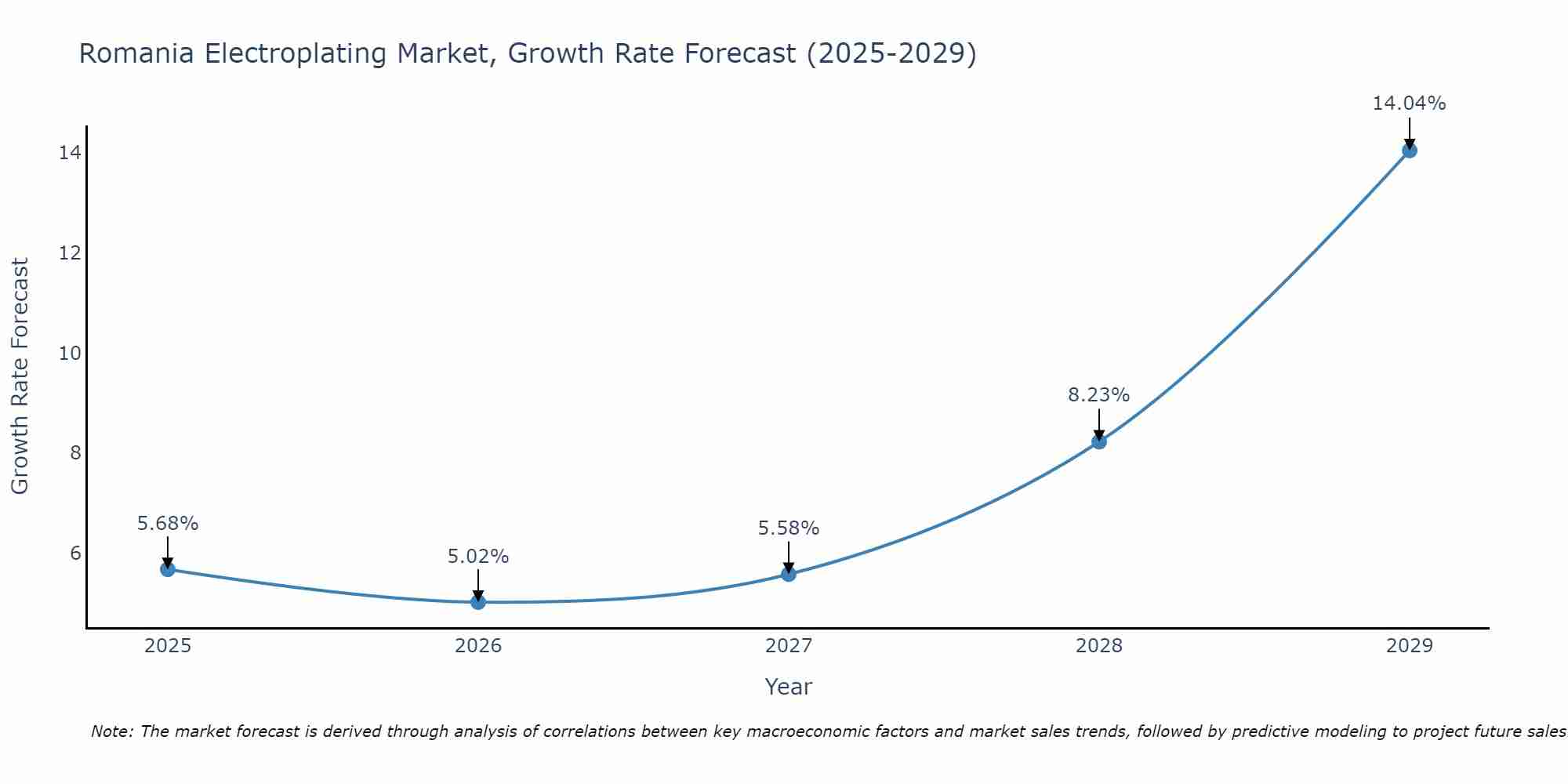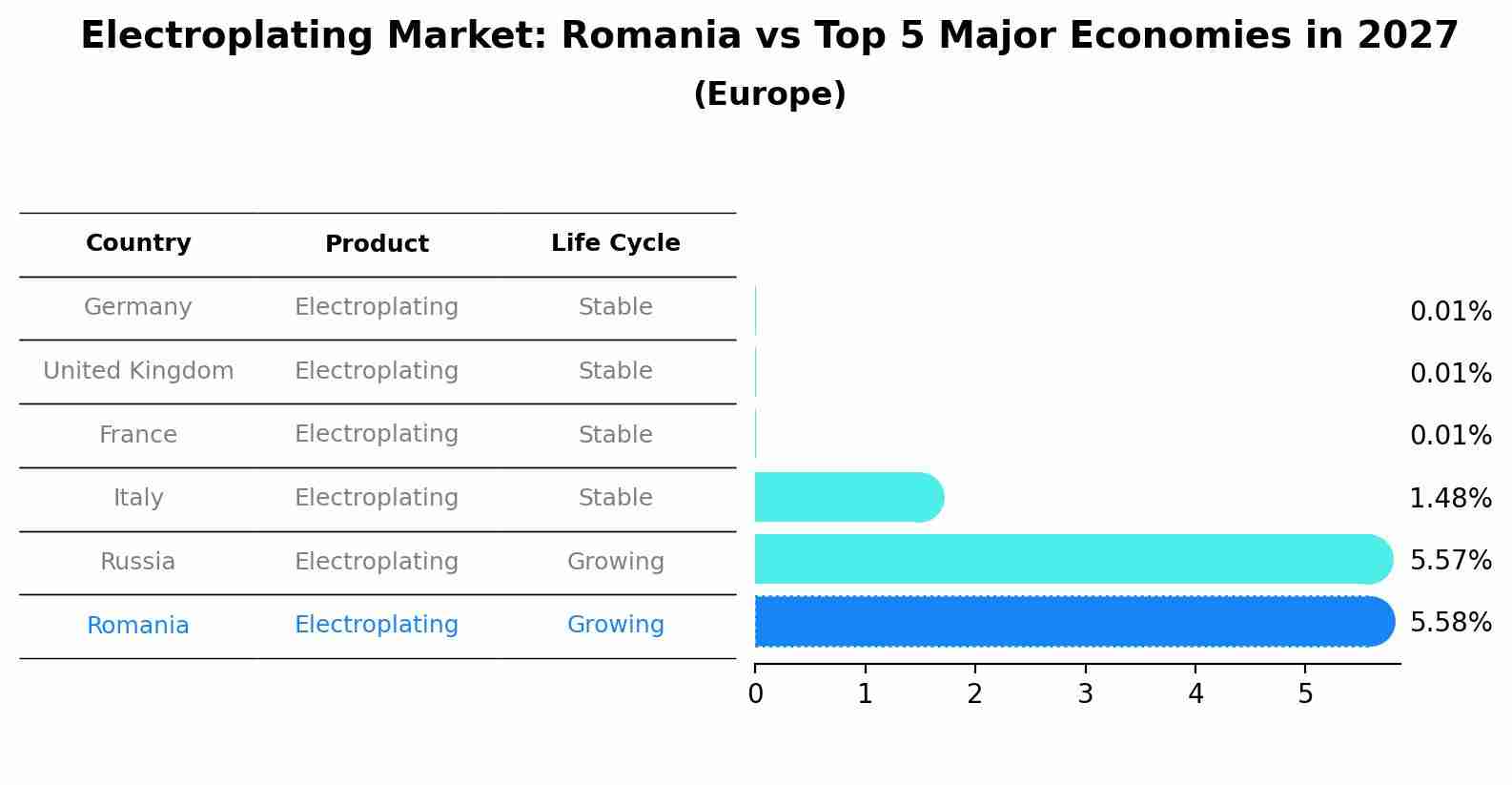Romania Electroplating Market Outlook | Value, Industry, Analysis, COVID-19 IMPACT, Size, Forecast, Companies, Growth, Trends, Share & Revenue
| Product Code: ETC104617 | Publication Date: Jun 2021 | Updated Date: Jun 2025 | Product Type: Report | |
| Publisher: 6Wresearch | Author: Shubham Padhi | No. of Pages: 70 | No. of Figures: 35 | No. of Tables: 5 |
Romania Electroplating Market Size Growth Rate
The Romania Electroplating Market is projected to witness mixed growth rate patterns during 2025 to 2029. The growth rate starts at 5.68% in 2025 and reaches 14.04% by 2029.

Electroplating Market: Romania vs Top 5 Major Economies in 2027 (Europe)
The Electroplating market in Romania is projected to grow at a growing growth rate of 5.58% by 2027, highlighting the country's increasing focus on advanced technologies within the Europe region, where Germany holds the dominant position, followed closely by United Kingdom, France, Italy and Russia, shaping overall regional demand.

Romania Electroplating Market Overview
The Romania Electroplating Market is experiencing steady growth driven by increasing demand from industries such as automotive, electronics, and aerospace. The market is characterized by a competitive landscape with key players offering a wide range of electroplating services for various applications. Technological advancements in electroplating processes, such as the adoption of eco-friendly and efficient methods, are contributing to the market`s expansion. The automotive sector is a major contributor to the market, with the rising production of vehicles in Romania boosting the demand for electroplated components. Additionally, the electronics industry`s growth is fueling the need for high-quality electroplating services to enhance the durability and performance of electronic devices. Overall, the Romania Electroplating Market is poised for further growth as industries continue to prioritize surface finishing techniques for improved product aesthetics and functionality.
Romania Electroplating Market Trends
The Romania Electroplating Market is witnessing several key trends. One prominent trend is the increasing adoption of environmentally friendly electroplating processes to reduce the industry`s environmental impact. Companies are investing in technologies such as trivalent chromium plating and other eco-friendly alternatives to comply with stringent regulations and meet consumer demand for sustainable practices. Additionally, there is a growing focus on automating and digitizing electroplating operations to improve efficiency, productivity, and quality control. This trend is driven by the need to enhance process repeatability and reduce human error while also addressing the labor shortage in the industry. Overall, the Romania Electroplating Market is evolving towards more sustainable and technologically advanced practices to meet market demands and regulatory requirements.
Romania Electroplating Market Challenges
The Romania Electroplating Market faces several challenges, including stringent environmental regulations regarding the disposal of hazardous waste generated during the electroplating process. Compliance with these regulations can increase operational costs for electroplating companies. Additionally, there is a shortage of skilled labor in the industry, leading to difficulties in finding qualified workers to operate and maintain electroplating equipment effectively. Economic uncertainties and fluctuations in raw material prices also pose challenges for companies operating in the electroplating market in Romania. Finally, increasing competition from low-cost producers in other countries can put pressure on local companies to remain competitive while maintaining high-quality standards. Overall, navigating these challenges requires strategic planning, investment in technology and training, and a strong focus on sustainability and compliance.
Romania Electroplating Market Investment Opportunities
The Romania Electroplating Market presents promising investment opportunities due to the growing demand for electroplating services in various industries such as automotive, electronics, and aerospace. With the country`s strategic location in Europe and its skilled workforce, foreign investors can capitalize on the increasing trend of outsourcing electroplating processes to Romania for cost-effective solutions. Additionally, the government`s focus on attracting foreign direct investment and improving infrastructure further enhances the market`s attractiveness for investors. Investing in electroplating facilities in Romania can offer long-term potential for growth and profitability, especially with the rising importance of surface treatments for enhancing product performance and aesthetics in the manufacturing sector. Conducting a thorough market analysis and understanding the specific needs of key industries can help investors identify the most lucrative opportunities in the Romania Electroplating Market.
Romania Electroplating Market Government Policy
The Romanian government has implemented various policies to regulate the Electroplating Market. These include environmental regulations aimed at reducing the impact of electroplating activities on the environment, such as wastewater management and air pollution control. Additionally, there are guidelines in place to ensure workplace safety and health standards are met by Electroplating companies. The government also promotes research and development in the industry to encourage innovation and sustainability. Overall, the government`s policies in Romania emphasize the importance of responsible and sustainable practices in the Electroplating Market to protect both the environment and the well-being of workers in the industry.
Romania Electroplating Market Future Outlook
The future outlook for the Romania Electroplating Market appears positive, driven by factors such as increasing demand from industries like automotive, electronics, and aerospace for high-quality surface finishing solutions. The market is expected to witness growth due to advancements in technology leading to improved efficiency and environmental sustainability in electroplating processes. Additionally, the rising focus on enhancing the aesthetics and durability of products, along with stringent regulations promoting the use of eco-friendly plating techniques, will further propel market expansion. Collaboration between key players and research institutions for developing innovative plating solutions is likely to drive market competitiveness and growth in the coming years, positioning Romania as a key player in the global electroplating industry.
Key Highlights of the Report:
- Romania Electroplating Market Outlook
- Market Size of Romania Electroplating Market, 2021
- Forecast of Romania Electroplating Market, 2027
- Historical Data and Forecast of Romania Electroplating Revenues & Volume for the Period 2018 - 2027
- Romania Electroplating Market Trend Evolution
- Romania Electroplating Market Drivers and Challenges
- Romania Electroplating Price Trends
- Romania Electroplating Porter's Five Forces
- Romania Electroplating Industry Life Cycle
- Historical Data and Forecast of Romania Electroplating Market Revenues & Volume By Metal for the Period 2018 - 2027
- Historical Data and Forecast of Romania Electroplating Market Revenues & Volume By Gold for the Period 2018 - 2027
- Historical Data and Forecast of Romania Electroplating Market Revenues & Volume By Copper for the Period 2018 - 2027
- Historical Data and Forecast of Romania Electroplating Market Revenues & Volume By Nickel for the Period 2018 - 2027
- Historical Data and Forecast of Romania Electroplating Market Revenues & Volume By Others for the Period 2018 - 2027
- Historical Data and Forecast of Romania Electroplating Market Revenues & Volume By Type for the Period 2018 - 2027
- Historical Data and Forecast of Romania Electroplating Market Revenues & Volume By Barrel Plating for the Period 2018 - 2027
- Historical Data and Forecast of Romania Electroplating Market Revenues & Volume By Rack Plating for the Period 2018 - 2027
- Historical Data and Forecast of Romania Electroplating Market Revenues & Volume By Continuous Plating for the Period 2018 - 2027
- Historical Data and Forecast of Romania Electroplating Market Revenues & Volume By Line Plating for the Period 2018 - 2027
- Historical Data and Forecast of Romania Electroplating Market Revenues & Volume By End-User Industry for the Period 2018 - 2027
- Historical Data and Forecast of Romania Electroplating Market Revenues & Volume By Automotive for the Period 2018 - 2027
- Historical Data and Forecast of Romania Electroplating Market Revenues & Volume By Electrical and Electronics for the Period 2018 - 2027
- Historical Data and Forecast of Romania Electroplating Market Revenues & Volume By Aerospace and Defense for the Period 2018 - 2027
- Historical Data and Forecast of Romania Electroplating Market Revenues & Volume By Medical for the Period 2018 - 2027
- Historical Data and Forecast of Romania Electroplating Market Revenues & Volume By Others for the Period 2018 - 2027
- Romania Electroplating Import Export Trade Statistics
- Market Opportunity Assessment By Metal
- Market Opportunity Assessment By Type
- Market Opportunity Assessment By End-User Industry
- Romania Electroplating Top Companies Market Share
- Romania Electroplating Competitive Benchmarking By Technical and Operational Parameters
- Romania Electroplating Company Profiles
- Romania Electroplating Key Strategic Recommendations
Frequently Asked Questions About the Market Study (FAQs):
- Single User License$ 1,995
- Department License$ 2,400
- Site License$ 3,120
- Global License$ 3,795
Search
Thought Leadership and Analyst Meet
Our Clients
Related Reports
- Germany Breakfast Food Market (2026-2032) | Industry, Share, Growth, Size, Companies, Value, Analysis, Revenue, Trends, Forecast & Outlook
- Australia Briquette Market (2025-2031) | Growth, Size, Revenue, Forecast, Analysis, Trends, Value, Share, Industry & Companies
- Vietnam System Integrator Market (2025-2031) | Size, Companies, Analysis, Industry, Value, Forecast, Growth, Trends, Revenue & Share
- ASEAN and Thailand Brain Health Supplements Market (2025-2031) | Strategy, Consumer Insights, Analysis, Investment Trends, Opportunities, Growth, Size, Share, Industry, Revenue, Segments, Value, Segmentation, Supply, Forecast, Restraints, Outlook, Competition, Drivers, Trends, Demand, Pricing Analysis, Competitive, Strategic Insights, Companies, Challenges
- ASEAN Bearings Market (2025-2031) | Strategy, Consumer Insights, Analysis, Investment Trends, Opportunities, Growth, Size, Share, Industry, Revenue, Segments, Value, Segmentation, Supply, Forecast, Restraints, Outlook, Competition, Drivers, Trends, Demand, Pricing Analysis, Competitive, Strategic Insights, Companies, Challenges
- Europe Flooring Market (2025-2031) | Outlook, Share, Industry, Trends, Forecast, Companies, Revenue, Size, Analysis, Growth & Value
- Saudi Arabia Manlift Market (2025-2031) | Outlook, Size, Growth, Trends, Companies, Industry, Revenue, Value, Share, Forecast & Analysis
- Uganda Excavator, Crane, and Wheel Loaders Market (2025-2031) | Strategy, Consumer Insights, Analysis, Investment Trends, Opportunities, Growth, Size, Share, Industry, Revenue, Segments, Value, Segmentation, Supply, Forecast, Restraints, Outlook, Competition, Drivers, Trends, Demand, Pricing Analysis, Competitive, Strategic Insights, Companies, Challenges
- Rwanda Excavator, Crane, and Wheel Loaders Market (2025-2031) | Strategy, Consumer Insights, Analysis, Investment Trends, Opportunities, Growth, Size, Share, Industry, Revenue, Segments, Value, Segmentation, Supply, Forecast, Restraints, Outlook, Competition, Drivers, Trends, Demand, Pricing Analysis, Competitive, Strategic Insights, Companies, Challenges
- Kenya Excavator, Crane, and Wheel Loaders Market (2025-2031) | Strategy, Consumer Insights, Analysis, Investment Trends, Opportunities, Growth, Size, Share, Industry, Revenue, Segments, Value, Segmentation, Supply, Forecast, Restraints, Outlook, Competition, Drivers, Trends, Demand, Pricing Analysis, Competitive, Strategic Insights, Companies, Challenges
Industry Events and Analyst Meet
Whitepaper
- Middle East & Africa Commercial Security Market Click here to view more.
- Middle East & Africa Fire Safety Systems & Equipment Market Click here to view more.
- GCC Drone Market Click here to view more.
- Middle East Lighting Fixture Market Click here to view more.
- GCC Physical & Perimeter Security Market Click here to view more.
6WResearch In News
- Doha a strategic location for EV manufacturing hub: IPA Qatar
- Demand for luxury TVs surging in the GCC, says Samsung
- Empowering Growth: The Thriving Journey of Bangladesh’s Cable Industry
- Demand for luxury TVs surging in the GCC, says Samsung
- Video call with a traditional healer? Once unthinkable, it’s now common in South Africa
- Intelligent Buildings To Smooth GCC’s Path To Net Zero


















